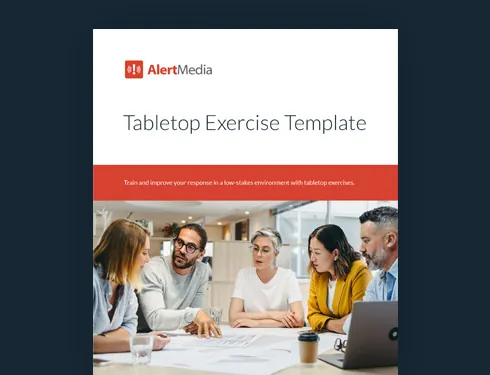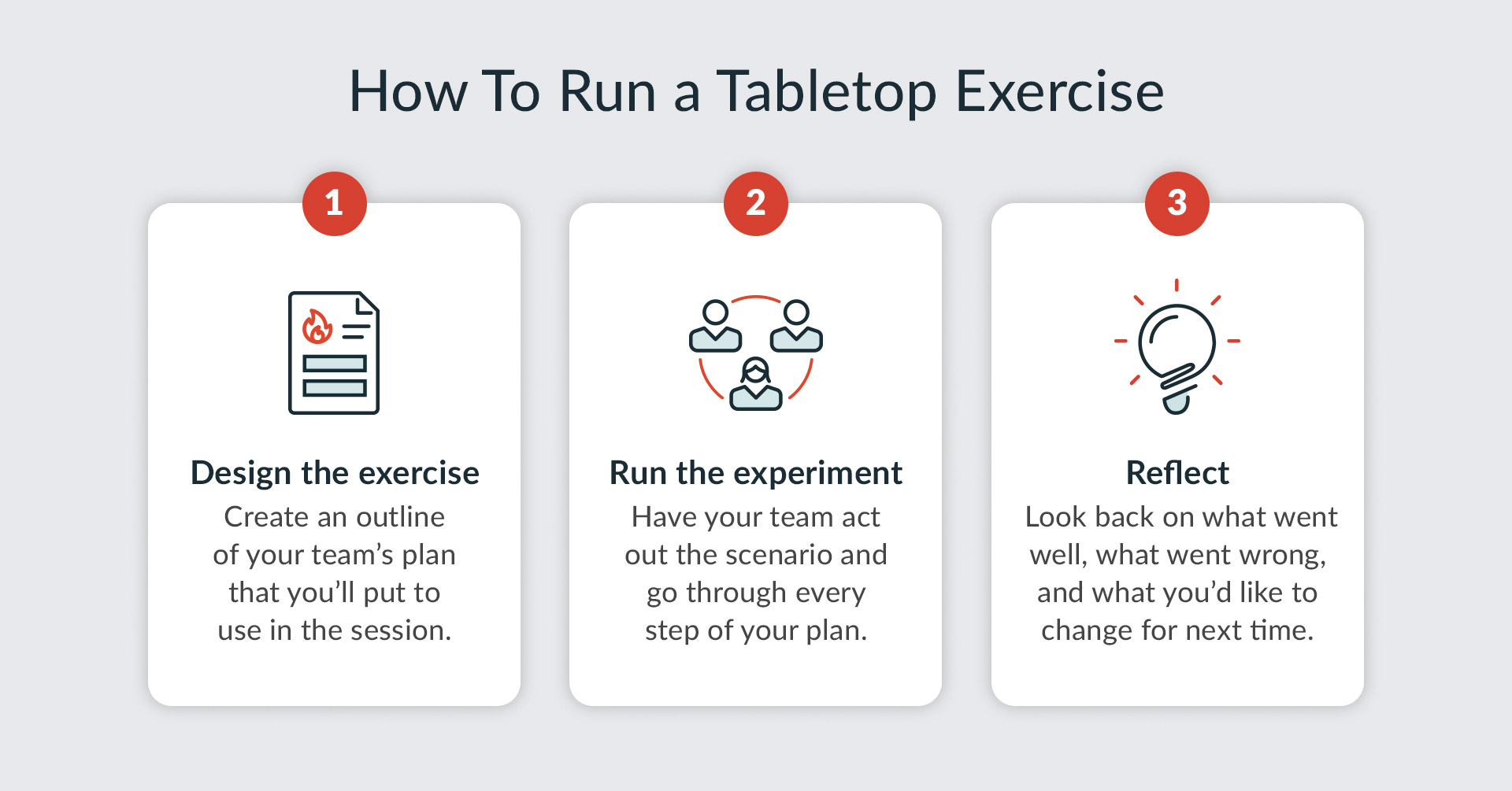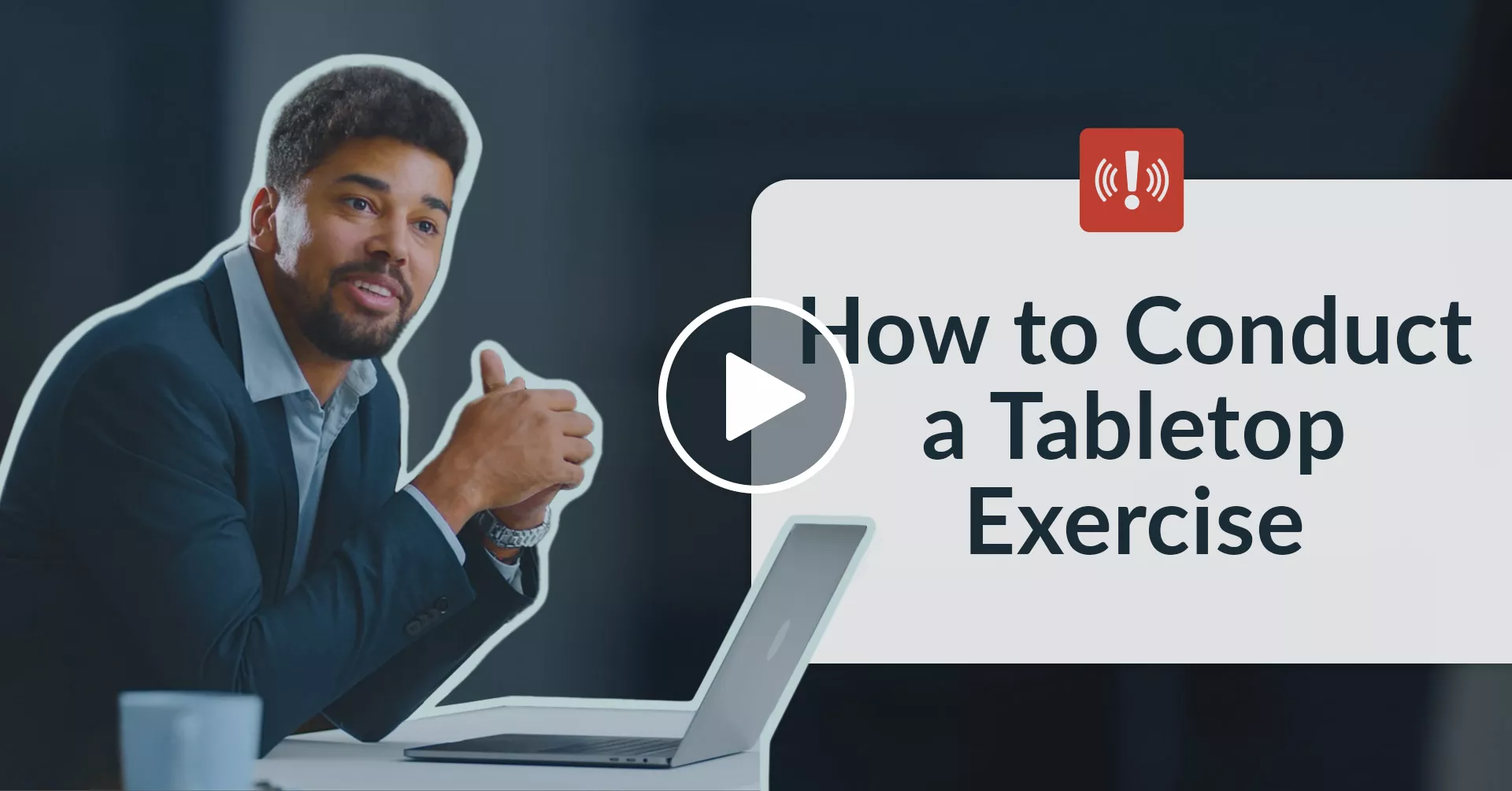Learn how a disaster recovery exercise strengthens your business continuity plan (BCP). Get templates, real examples, and expert tips for effective preparation.

Disaster Recovery Tabletop Exercises & Other Drills Prepare You to Bounce Back

In today’s complex business landscape, organizations cannot afford prolonged downtime or gaps in business operations. Effective disaster recovery testing is crucial for validating recovery strategies, reducing failover times, and ensuring recovery processes meet defined recovery time objectives (RTOs). By conducting the right type of test regularly, businesses can proactively identify vulnerabilities, streamline response actions, and confidently safeguard their operational resilience against unforeseen disruptions.
This blog will explore various exercises—including disaster recovery tabletop exercises, functional drills, and full-scale simulations—to equip your organization with practical guidance for enhancing preparedness and resilience.
Get the Tabletop Exercise Template
Why Disaster Recovery Exercises Are Essential for Every Organization
Organizations undertake disaster recovery exercises because simply hoping their plans will work isn’t enough. Disasters rarely follow predictable patterns, and untested plans leave businesses vulnerable. Regular disaster recovery exercises ensure teams understand their roles, anticipate challenges, and respond effectively under pressure.
Benefits of disaster recovery exercises include:
- Improving overall preparedness by identifying weaknesses before a crisis
- Ensuring business continuity by minimizing downtime during disruptions
- Revealing critical gaps for proactive management
- Meeting regulatory compliance requirements, especially in industries like finance, healthcare, and technology
- Demonstrating due diligence to protect against legal or reputational harm
Neglecting these exercises is risky—it exposes organizations to prolonged disruptions, financial losses, and reputational damage. Regularly conducting disaster recovery exercises transforms uncertainty into assurance, proving your team’s readiness and your plan’s reliability.
Test Your Plans With a Disaster Recovery Tabletop Exercise
A tabletop exercise allows you to test your disaster recovery plans and identify gaps. You don’t have to test every part of a business continuity plan or disaster response simultaneously. You can test in segments.
A disaster recovery tabletop exercise helps you assess your recovery capabilities in an emergency management plan for a natural disaster, cyberattack, infrastructure failure, or other crisis. Every disaster has two distinct phases: the disaster itself and the following recovery period. While the immediate disaster may cause the most significant damage, the long-term effects on critical infrastructure are often more challenging to address. Your tabletop exercise is a discussion-based opportunity to test your risk management strategy during that latter phase.
In this video, AlertMedia’s Senior VP of Safety Solutions, Peter Steinfeld, explores different types of exercises and tabletop exercise scenarios you can adapt for your organization.
Frequency and Program Development for DR Exercises
The effectiveness of disaster recovery (DR) exercises hinges significantly on how frequently and systematically they’re conducted. Determining the right frequency depends on the type of exercise and your organization’s unique needs:
- Tabletop exercises should ideally occur annually or semi-annually, especially when new team members join or plans significantly change.
- Full-scale exercises involving physical assets or IT systems might occur less frequently, typically annually or biannually—due to complexity and resource requirements.
Several factors influence exercise frequency, including:
- Industry regulations and compliance requirements (e.g., finance, healthcare, technology)
- Organizational risk profile and past incident history
- Significant operational changes, such as new technologies, mergers, or organizational restructuring
Developing a robust DR exercise program involves a structured, stepwise approach:
- Start with foundational exercises, like tabletop scenarios, to clarify roles and procedures.
- Progressively introduce complexity, eventually integrating full-scale simulations that test technical and human elements.
- Integrate exercises into regular operational calendars and clearly document outcomes, follow-ups, and improvements.
Documenting your exercise program delivers greater value than ad hoc testing by providing consistency, clarity, and accountability. Clearly defined roles and responsibilities—supported by appropriate tools, templates, and reporting mechanisms—ensure your program’s ongoing success and readiness for real-world disruptions.
Execution and Best Practices for Conducting DR Exercises
Effectively conducting disaster recovery exercises requires clear execution, precise coordination, and proactive communication. Successful exercises hinge on practical preparation—ensuring everyone involved understands their roles and responsibilities—and thoughtful facilitation that encourages active participation. Clear, ongoing communication throughout each exercise enhances team alignment and ensures actionable insights emerge, ultimately strengthening your organization’s resilience to real-world disruptions.

A tabletop exercise involves three broad steps you can adapt to test your disaster recovery readiness.
Step #1: Designing Your Disaster Recovery Exercise
To prepare for your disaster recovery tabletop exercise, determine your goals, participants, and scenario script. Specifically, you need to test your existing plan with the individuals directly responsible for implementing it in a realistic scenario.
Setting SMART exercise objectives for your TTX
As you test your disaster recovery plan, you’ll want to build goals around it. These goals should be SMART, which stands for specific, measurable, achievable, relevant, and time-bound.
Smart exercise objectives for your disaster recovery might center on your IT systems and the networks needed to run your business. You might focus on metrics related to your systems and services’ recovery time and recovery point objectives.
You may also set goals around how long it takes to get critical infrastructure up and running or how well your emergency communication plan works. This will help you identify clear success metrics you can aim for as you refine your strategy and help your team members improve their responses.
Download our helpful Tabletop Exercise Template for more guidance on setting goals and planning your tabletop exercise.
Documenting task ownership and escalation paths ensures accountability and prevents confusion during emergencies. Each critical task should have a primary owner and at least one alternate who can step in if the primary person is unavailable. Define escalation paths for situations requiring higher-level decision-making or specialized expertise. For instance, if a facilities manager responsible for activating generators is unreachable, a documented alternate should immediately follow a predefined escalation path.
Brief everyone involved on the exercise goals and their roles, and provide copies of the exercise plan. There are four key parties in a tabletop exercise:
FacilitatorA facilitator guides the exercise in real time and keeps it moving toward the objectives.
| ParticipantsMost parties involved will be participants who will answer questions and respond to scenarios.
| ObserversObservers might monitor the process and provide insight specific to their jobs. Someone from HR or facilities is a typical example.
| EvaluatorAn evaluator acts as an unbiased reviewer, tracking strengths and opportunities in the plan as part of the evaluation program.
|
Everyone who falls into one of these roles should have a clear outline of all their responsibilities for disaster recovery. This ensures each individual understands their specific tasks, knows how to execute them effectively, and can contribute to the overall success of the recovery plan.
These outlined responsibilities help maintain organization and coordination during tabletop exercises and, more importantly, in real disaster scenarios, where a well-prepared team is essential for a swift and effective response.
Establish communication protocols and dedicated channels, such as instant messaging apps or virtual collaboration tools like Microsoft Teams or Slack, to ensure real-time coordination during your exercise. Provide guidance on how and when to communicate updates, who will compile status reports, and how to escalate information when necessary. Regular check-ins or structured status updates every 15–30 minutes during exercises can significantly enhance clarity and responsiveness.
Automation and technology in disaster recovery exercises
Using automated runbooks, digital checklists, and dashboards helps streamline task management, improve communication clarity, and provide real-time visibility into exercise progress. Tools such as Trello, Asana, or specialized incident management software offer easy ways to track actions, assign ownership, and ensure timely task completion. These platforms also help document exercise progress and outcomes, simplifying post-exercise analysis. Consider the following tools to boost the effectiveness of your exercise:
- Automated runbooks: Provide step-by-step guidance, ensuring consistency, reducing manual errors, and assigning ownership. Automation standardizes response actions and streamlines escalation paths, freeing teams to concentrate on critical decisions.
- Real-time dashboards: Enable facilitators and stakeholders to instantly monitor exercise progress. Dashboards provide immediate visibility into task completion, participant engagement, and emerging bottlenecks, allowing real-time scenario adjustments.
- Automated documentation and audit trails: Offer accurate, tamper-proof logs essential for compliance and audit requirements. Automated tracking of actions, timestamps, and task ownership simplifies reporting and demonstrates due diligence to auditors.
- Digital checklists and collaboration tools: Tools like Incident Response, Trello, Asana, and Microsoft Teams facilitate task assignment, progress tracking, and seamless communication, especially for distributed or remote teams.
- Post-exercise reporting and analytics: Automation accelerates the evaluation process by swiftly generating comprehensive reports and analytics. This helps organizations quickly identify gaps, track follow-up actions, and foster continuous improvement.
Setting up your tabletop exercise scenarios
Your disaster scenario doesn’t have to be as detailed as the most recent Hollywood blockbuster, but it should be clear and realistic. The script should center on the aftermath of a specific disaster, such as a hurricane or earthquake. A typical scenario might look like this:
A Category 3 hurricane has struck the coastal region, causing widespread power outages and road blockages. Your organization’s main data center, located in the affected area, has lost power, and the roads leading to the center are impassable due to fallen trees and debris. Current estimates from utility providers say power will be restored in the next few days, and cleanup crews are working to clear the roads in the coming week. Your goal is to mitigate disruptions in your service from the data center outage until power is restored.
Present the scenario, along with a brief, the disaster recovery plan, and a copy of the goals to your participants, observers, and evaluators. With this information in hand, you’re ready to start your exercise.
Step #2: Run Your Tabletop Exercise
The facilitator begins the tabletop exercise with a brief. They provide a disaster scenario to all the participants, observers, and evaluators, outlining the exercise objectives, responsibilities, and resources. They should read this information aloud and go over any questions in detail.
Once the initial introduction is complete, the facilitator guides a walkthrough of the emergency response plan. To stimulate active engagement, they use direct questions such as, “In facility four, the power is out. What’s the initial response?” This prompts a discussion on the emergency response plan, where participants can request further information. For instance, a participant might respond, “The facilities manager will activate the building’s generator.” The facilitator should then delve deeper by posing follow-up questions such as:
- What’s the process for activating the generator?
- Who is responsible for coordinating with the facilities manager?
- What happens if the facilities manager is unavailable? Who is the alternate authorized to act?
- What resources will be needed to continue running the generator?
- How will those resources be accessed?
- Are there any other stakeholders who will be affected?
Each question is an opportunity to deepen the participants’ answers and help them think about potential gaps in their emergency preparedness. By probing for additional details and exploring different aspects of the response, the facilitator ensures that the exercise thoroughly tests the organization’s readiness and identifies areas for improvement in the disaster recovery plan. This constructive dialogue during the exercise fosters better preparation and a more effective response in real-life scenarios.
The facilitator should also include “injects” to keep the participants thinking. Injects—unexpected scenario updates introduced during the exercise—test your team’s adaptability and decision-making under pressure. Best practices for injects include gradually escalating complexity or introducing sudden changes, like communication breakdowns or system failures, to mirror real-world disruptions closely. For example, you might initially announce a power outage and later escalate with news that backup generators have failed. Document each inject and ensure the facilitator closely manages timing and participant reactions to maintain focus and realistic pressure.
Coca-Cola Pivots During a Natural Disaster
The period following a disaster can be as risky and demanding as the storm. Additional crisis management challenges can emerge that you still need to consider. Plans that seemed well-written during the prep phase may not be practical for real-world situations, leading to recovery delays.
When Gianetta Jones, Vice President and Chief People Officer at Coca-Cola Bottling, had to contend with the strongest storm to hit the Florida panhandle on record, Hurricane Michael, the company had dozens of plans in place. They were well-prepared to support an estimated 3,000 employees across 14 affected locations in the Gulf. Then, the unexpected intensity of the hurricane took out the cell phone infrastructure on which they relied for communication.
It was a stark reminder that incident management goes beyond initial planning. Even the most comprehensive business continuity strategies can face unexpected setbacks. “You can never underestimate a storm,” said Gianetta. “We were thrown a curveball with Hurricane Michael because we did not prepare for the telephone infrastructure, and cell service was severely damaged. We had to pivot and purchase several expensive satellite phones for our local operators to communicate with us at the corporate office.” Their situation underscored the importance of continuous adaptability and readiness throughout the recovery phase.
The team was able to pivot that quickly because they’re seasoned at dealing with disaster recovery and implementing incident response plans. However, companies without experienced disaster recovery team members would struggle. The only way to improve is through practice, but in the middle of a natural disaster, active shooter event, cybersecurity breach, or pandemic is not the time to do so. Instead, you can prepare now with a tabletop exercise for disaster recovery preparedness.
Read more about how Coca-Cola prioritizes safety and communication.
Another example would be to introduce a scenario like the failure of cell phone infrastructure due to high winds and flooding, as seen in the case of Coca-Cola in Panama City during Hurricane Michael. These injects test the adaptability of the recovery plan and help participants think on their feet.
Finally, as you’re running the exercise, be sure to document any new information that comes up. For example, you may have discovered that no alternative has been assigned for your facility’s manager’s role of turning on the generator. You would document this, establish an alternate to fill that gap, and revisit it during the review stage.
Step #3: Reflect on Your TTX With an After-Action Report
The final stage of every tabletop exercise is to complete an after-action review. The AAR allows you to examine your response and identify gaps in your plan so you can improve. You can share the highlights of an after-action report with your team and encourage everyone to enhance their preparedness. You can also take this information into your full-scale exercise to test your plan from beginning to end and involve even more stakeholders in the recovery test.
Evaluation and post-exercise assessment
The success of disaster recovery exercises extends beyond their execution—practical evaluation and post-exercise assessment are critical for translating practice into real-world readiness. Key insights can be lost without thorough evaluation, leaving gaps unaddressed.
Documenting observations and outcomes
Detailed note-taking and documentation throughout the exercise are essential. Assign dedicated observers or evaluators to capture real-time observations, decisions made, challenges encountered, and notable outcomes. Clear, structured documentation serves as a valuable resource for identifying trends, strengths, and areas for improvement.
Conducting structured after-action reviews
Post-exercise reviews, or after-action reviews (AARs), should involve all exercise participants, evaluators, and key stakeholders. An effective AAR should systematically cover:
- Exercise objectives vs. actual outcomes
- Key successes and best practices identified
- Challenges or gaps encountered during the exercise
- Recommendations for improvement and follow-up actions
Analyzing results and soliciting feedback
Compare exercise outcomes directly against your initial objectives. Highlight discrepancies to identify gaps or areas needing further development. Actively solicit participant feedback through structured surveys or facilitated discussions, ensuring insights from all perspectives are captured.
Implementing lessons learned
The most valuable outcome of your assessment process is translating lessons learned into actionable improvements. Document recommendations, assign ownership, and establish timelines for updating disaster recovery plans and protocols. This continuous improvement cycle ensures your organization evolves with each exercise, steadily enhancing resilience and preparedness for real-world disruptions.
Preparing to Face the Unknown
A disaster recovery tabletop exercise is an interactive opportunity to practice your response. Even the best-prepared organizations can face unexpected setbacks, like when Coca-Cola Bottling discovered a communications gap during a Category 5 hurricane. A tabletop exercise ensures you don’t find these gaps when emotions are high and resources are low. Instead, you’re prepared well in advance for any unexpected challenges.





